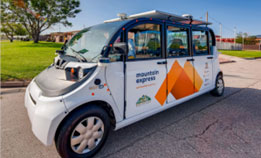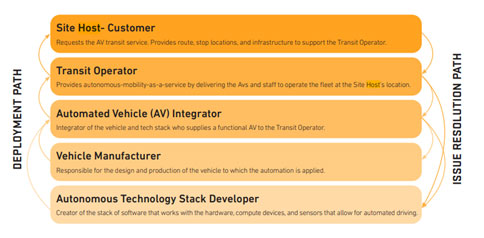Rising in popularity and reliability, Automated Vehicles (AVs) may one day help solve many of the logistical, congestion, pollution, and transportation problems facing our world. As with all other emerging technologies, however, those who want to reap the benefits must learn from hands-on experience in field tests and pilot deployments. US Ignite, a nonprofit organization in the United States, assisted the U.S. Department of Defense with two distinct AV pilot projects: one at Fort Carson, Colorado, and one at Marine Corps Air Station (MCAS) Miramar in San Diego, California. These projects provided a glimpse of the power of AVs and how future deployments can be optimized to ensure safety, improve logistical efficiency, and accelerate market adoption.

Snapshot 1: Fort Carson Mountain Express Automated Vehicle Shuttle
PROJECT OVERVIEW
The Fort Carson AV Shuttle provided transportation services to four stations along a 3.1-mile fixed route, utilizing two vehicles. The two-year pilot, funded and managed by the U.S. Army Engineer Research and Development Center (ERDC), aimed to demonstrate how the military could utilize automated vehicles to enhance on-site delivery, improve public safety, and reduce costs.
OUTCOMES
- Shuttle transported over 200 passengers in six months of active operations
- Pilot demonstrated the benefits and limitations of using an AV vehicle on a military installation
- AV collected valuable data to improve future projects

Snapshot 2: MCAS Miramar Automated Vehicle Package Delivery Shuttle Project
PROJECT OVERVIEW
MCAS Miramar used two automated vehicles to deliver packages over a fixed, two-mile route. The project marked the first time a DoD facility tried an AV-powered delivery application. The pilot was funded by the Department of the Navy, Office of Naval Research, and Naval Information Warfare Center (NIWC) Pacific and supported by NavalX SoCal Tech Bridge.
OUTCOMES
- The shuttle delivered more than 260 packages over 39 operational days spanning 13 weeks
- AV Shuttle achieved autonomous operation in over 70% of the route
- AV collected data to improve future projects
Key Takeaways
Drawing on the experience gained from these two AV pilot projects, US Ignite compiled several takeaways that should prove valuable to any organization or office considering the addition of an AV component to their operations.
UNDERSTANDING TECHNOLOGY PARTNERS
All AV efforts rely on a team of expert partners. From the outset, any organization, company, or office initiating an AV deployment should develop a foundational understanding of the various vendor types and roles involved in deploying a new AV. At the time of the US Ignite pilots, these included the site host, transit operator, AV integrator, vehicle manufacturer, and developer of the autonomous technology stack.
The graphic below presents these categories, any of which may overlap or combine as the market continues to mature. The arrows shown depict the Deployment Path and the Issue Resolution Path, both of which involve all partners in varied order.

Site hosts need to stay informed about the latest integrated approaches available from vendors in the AV market.
INTROSPECTIVE LOOK AT INFRASTRUCTURE
Infrastructure requirements can make or break any AV deployment. At both Fort Carson and MCAS Miramar, infrastructure questions and challenges arose. During the planning phase of an AV deployment, it is important to consider questions such as:
- Does the AV need to be stored in a temperature-controlled space?
- How and when will the vehicle have access to electrical service or an EV charge infrastructure (Level 2 vehicle charging recommended)?
- Is the storage and charging area as close to the designated route as possible (to maximize the vehicle range and service hours)?
- Will the vehicle require any operational staff? If so, will basic office amenities – such as desks, chairs, bathrooms, and parking or transportation – be available to them?
Asking and answering these and other similar questions about the setup and physical resources can save a headache down the road.
ON TO THE OPERATION AND ROUTE
The Automated Vehicle Safety Consortium TM (AVSC) explains the concept of Operational Design Domain (ODD) as the described conditions under which an automated vehicle is designed to function, including ideal environment, geography, time, Internet connectivity, and roadway characteristics. Having a mutually agreed-upon ODD increases the likelihood of a successful AV deployment. The ODD can be defined and agreed upon by all the technology partners at the start of the project. Alternatively, the host can dedicate time to determining the ODD before selecting technology partners and use the ODD in recruiting vendors that can agree on the ODD and meet the technical requirements.
The ODD should also help the host set the AV’s route, including total distance, number of turns, maximum speed, and acceptable traffic congestion. Depending on the AV’s maximum speed and the presence of other vehicles, the route may need to stick to roads that are wide enough for other cars to pass the AV. If the AV makes any pick-up and drop-off stops, the host should also make these stops. The host might also want to consider posting signs that inform others about the AV service and protecting the route from roadway obstructions (such as unexpected parked vehicles).
LOOKING AHEAD
Greater speed, efficiency, and versatility are on the horizon for AVs, but achieving this goal will require critical and thoughtful planning involving a wide range of partners and stakeholders. US Ignite is excited to work with partners on future deployments and to iterate on both the underlying technologies and new AV-powered use cases.



